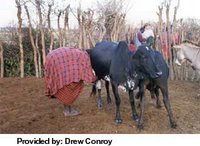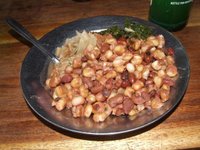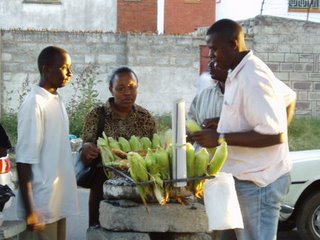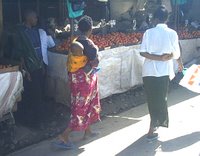[ . BACK to WORLDKIGO TOP . ]:::::::::::::::::::::::::::::::::::::::::::::::::::::::::::::::::::::::::::::::::::::::::::::::::::::
Maasai Cattle
***** Location: Kenya (Nairobi)
***** Season: Hot dry season, cool dry season
***** Category: Animal *****************************
Explanation
In the city of Nairobi and its suburbs, home to some 2 million people, Maasai cattle make an appearance regularly during the dry seasons, when vegetation becomes scarce in the Maasai countryside. More recently, since global warming started, the Maasai never quite leave Nairobi, even during the rainy seasons, but settle down in their temporary villages in the bush near the International Airport. But when drought strikes, they venture all the way into the city centre, browse along the main highways and in the public parks, and spread into the leafy suburbs of Karen to graze where they can still find grass.
 [Photo November 2005]
[Photo November 2005]The people of Nairobi are highly tolerant of the Maasai herds, and are well used to their strolling down dual carriageways, attended by their keepers clad in traditional red cloths. It is only when they take to narrow streets that they arouse irritation, as their horns are long and straight, and they have been known to break many a window in their search for grass.
The cattle graze along verges and in public parks, but cause very little damage to the roots and soil, as they keep gently moving along all the time on the dry earth. Anyone who plants a kitchen garden or a flower patch that is not securely fenced in, will not see much surviving after the Maasai cattle have passed, but I have never heard more than a moan about them, as everyone understands that the cattle too must eat.
 [Photo January 2006]
[Photo January 2006]
Maasais have a close and religious relationship with their cattle (see below), and above all else want them to thrive and multiply. The cattle always look well cared for, and are herded in a gentle manner by their keepers, who are usually paid by several owners to look after them. Their purpose is to own cattle, and only very rarely will they slaughter an animal for a celebration. They do, however, enjoy their milk and their blood and, unlike many African nations, have no allergy against milk, which from time immemorial they have enjoyed.
The current (2006) drought and famine, the worst for many decades, shows its severity by the fact that Maasai cattle are dying in large numbers even as the people too are suffering and dying. The article which you will find directly below concerns the work of a friend of mine, Ronnie Briggs, who returned to his Kenyan home in Kajiado (February 2006), after some months spent in Ireland.
Text and photos (c) Isabelle Prondzynski
xxxxxxxxxxxxxxxxxxxxxxxxxxxxx
Work Begins on Food Distribution Centres in Kajiado
January saw the launch of CMSIreland's 'Food for Thought' appeal, in response to the famine situation in Kenya. Ronnie Briggs, a CMSIreland Mission Partner, has recently travelled back to Kenya and is working to help deliver the programme on the ground.
Writing from Kajiado (in the heart of Maasai country) he says, "I have arrived safely and am beginning to get my head around what is going on here. Even though I have not yet travelled very far I can see that the famine and drought are hitting very hard - there is much distress and suffering. Dead animals are lying at the side of the road - including wild animals which is quite unusual as they are normally more suited to severe conditions than domestic animals. There are heaps of dead animals lying outside villages. When they can't get up in the morning they soon die and so they are heaped up and eventually burned. The smell is awful!"
The local church has been gathering together groups, pastors and evangelists from around the diocese in order to train them in how best to manage the distribution of food -- ensuring that it reaches the most needy. Now they are just waiting for enough food to arrive at the centres.
Ronnie says, "All the energies of the Diocese are extremely focused on this issue. I have already heard some awful stories of the effect of the famine in some of the remote parts of the Diocese. One man - a headmaster in a primary school - was almost in tears as he related the situation in Torosei - one of our nominated centres - as they have not received any help at all so far. This kind of story is repeated in numerous places all over the Diocese".
Quoted from here. xxxxxxxxxxxxxxxxxxxxxxxxxxxxx
Prayer for RainAlmighty God, Giver of life and strength,
creator of rain and sky, dust and earth,
preserver of people and plants and animals :
as our cattle leave their enclosures,
as we work on a dry and weary land,
we look to you, our heavenly showers,
quench our thirst, strengthen our herds,
raise our crops and refresh our land;
Through Jesus Christ, the water of life. Amen
-- Our Modern Services, 2002 (c) Anglican Church of Kenyaxxxxxxxxxxxxxxxxxxxxxxxxxxxxx
From Naomi Kipury's excellent "Oral Literature of the Maasai"(1983: East African Educational Publishers Ltd., PO Box 45314 Nairobi, Kenya).
The Origin of Cattle, collected by Naomi KipuryIn the beginning, the Maasai did not have any cattle. One day God called Maasinta, who was the first Maasai, and said to him: "I want you to make a large enclosure, and when you have done so, come back and inform me."
Maasinta went and did as he was instructed, and came back to report what he had done. Next, God said to him:
"Tomorrow, very early in the morning, I want you to go and stand against the outside wall of the house for I will give you something called cattle. But when you see or hear anything do not be surprised. Keep very silent."
Very early next morning, Maasinta went to wait for what was to be given him. He soon heard the sound of thunder and God released a long leather thong from heaven to earth. Cattle descended down this thong into the enclosure. The surface of the earth shook so vigorously that his house almost fell over.
Maasinta was gripped with fear, but did not make any move or sound. While the cattle were still descending, the Dorobo, who was a house-mate of Maasinta, woke up from his sleep. He went outside and on seeing the countless cattle coming down the strap, he was so surprised that he said "Ayieyieyie!", an exclamation of utter shock.
On hearing this, God took back the thong and the cattle stopped descending. God then said to Maasinta, thinking he was the one who had spoken: "Is it that these cattle are enough for you? I will never again do this to you, so you had better love these cattle in the same way I love you." That is why the Maasai love cattle very much.
How about the Dorobo? Maasinta was very upset with him for having cut God's thong. He cursed him thus: "Dorobo, are you the one who cut God's thong? May you remain as poor as you have always been. You and your offspring will for ever remain my servants. Let it be that you will live off animals in the wild. May the milk of my cattle be poison if you ever taste it." This is why up to this day the Dorobo still live in the forest and they are never given milk.
This page is part of Jens Finke's
Traditional Music and Cultures of Kenya
http://www.bluegecko.org/kenya/tribes/maasai/stories-cattle.htm
xxxxxxxxxxxxxxxxxxxxxxxxxxxxx
To the Maasai cattle are sacred and a direct gift from the heavens. Grass is also considered a blessing and sacred. When passing a fig tree, it is customary for the Maasai to push handfuls of grass between the roots, as homage to the source of their herds. One of the more common Maasai greetings is "
I hope your cattle are well".
http://www.magicalkenya.com/default.nsf/doc21/4YGEX3ADMY6?opendocument&l=1&e=1&s=1
xxxxxxxxxxxxxxxxxxxxxxxxxxxxx
The life of the Masai tribe of Kenya and Tanzania revolve around cattle. Virtually all social roles and status derive from the relationship of individuals to their cattle. Cow's milk, together with blood, is the staple food of the Masai who eat no fruit or grain. Once a month, blood is taken from living animals by shooting a small arrow into the neck. This blood is then mixed with milk in a gourd which has been washed with urine to prevent spoilage.
Masai cattle vary considerable due to the centuries old practice of stealing cattle from neighboring tribes. This is sanctioned by the Masai legend with relates that Ngai (God) sent them cattle at the beginning of time and gave them the sole right to keep them. Compared with cattle belonging to the surrounding tribes, Masai cattle are the largest and in the best condition. This is due largely to the generous amount of milk the young calves get.
As a rule, the Masai have so many cattle that only a portion of the milk is needed for human consumption and there is plenty left for the calves. Females stand 125 cm tall and weigh about 360 kg while bulls are 140 cm at the withers and weigh 400 kg. The breed has a characteristically small narrow head. The dewlap is quite large, the chest is relatively deep and the whole body is well muscled. Coloration varies although the Masai favor brindled animals.
 © Photo provided by Drew Conroyhttp://www.ansi.okstate.edu/breeds/cattle/masai/
© Photo provided by Drew Conroyhttp://www.ansi.okstate.edu/breeds/cattle/masai/xxxxxxxxxxxxxxxxxxxxxxxxxxxxx
Ngai
The Maasai believe in one God, whom they call Ngai. Ngai is neither male nor female, but seems to have several different aspects. For instance, there is the saying
Naamoni aiyai, which means "The She to whom I pray". There are two main manifestations of Ngai:
Ngai Narok which is good and benevolent and is black; and
Ngai Na-nyokie, which is angry and red, like the British. For a story which has them as separate gods, see Thunder and the Gods.
Ngai is the creator of everything. In the beginning, Ngai (which also means sky) was one with the earth, and owned all the cattle that lived on it. But one day the earth and sky separated, so that Ngai was no longer among men. The cattle, though, needed the material sustenance of grass from the earth, so to prevent them dying Ngai sent down the cattle to the Maasai by means of the aerial roots of the sacred wild fig tree, and told them to look after them. This they do to this day, quite literally taking the story as an excuse to relieve neighbouring tribes of their own livestock.
Any pursuit other than a pastoral one was considered insulting to Ngai and demeaning to them. No Maasai was willing to break the ground, even to bury the dead within it, for soil was sacred on account of its producing grass which fed the cattle which belonged to God... Equally, grass has acquired a semi-sacred aura, and is held in the fist as a sign of peace, and similarly held is used for blessings during rituals, a sheaf of grass being shaken at the people or animals being blessed.
No surprise, then, to find that cattle play an important role in ritual occasions, such as initiation, marriage, and the passage of one age-set to the next, where their sacrifice bridges the gap between man and God. Yet for all the deep significance cattle embody for the Maasai, a stupid person will still be referred to as a cow or a sheep!
http://www.meta-religion.com/World_Religions/maasai_religion.htm
***************************** Worldwide use*****************************
Things found on the way*****************************
HAIKUcold dew at sunrise --
thirsty soil, thirsty cattle
dust soon covers all Maasai cattle
Maasai cattle
thronging city streets
their silent guards
Isabelle Prondzynski, February 2006
xxxxxxxxxxxxxxxxxxxxxxxxxxxxx
Haiku from the drought of 2006
austere drought
withered grasses and trees
carcasses all overCatherine Njeri
ooo ooo ooo
austere drought
deserted manyattas
animal carcassesPatrick Wafula
manyattas are houses build with mud walls, where the Maasai live.
ooo ooo ooo
dry whirlwinds blow
Maasais and their cattle flee
carcasses and stenchTeresia Wanjiku
Bahati Poetry Haiku Club Meeting January 2006 :::::::::::::::::::::::::::::::::::::::::::::::::::::::::::::::::::::::::::::::::::::::::::::::::::::
maasai herdsmen
lead hungry cows across
an empty field James Bundi
January 2011*****************************Related words. Masai, Maasai, Massai
topic for Kenya haiku While it’s true that the Maasai are largely pastoralist, urbanization and other modern forces have forced others to adapt a new life though much informed by their former way of life.
The Urban Maasai still hold their culture dearly. They move along in clusters, holding their rungu and in most cases with their traditional dressings. Rarely will you see a Maasai walking alone. They have to a large extended defied the power of individualism. They live as a community. They communicate to one another through their mother tongue. They share the place of living thus minimizing the cost of living. In most cases they live in the building that they guard. In most cases this are building that are still under construction and those which are not yet rented.
Their economy is based on employment as guards. Maasai are believed to be good askaris due to their braveness. Thus also provide security to those who get home late, those who go to work in late hours. Beside provision of security the Maasai are employed in
nyama choma (roast meat) joints. In recent times they are been involved in small vending businesses – such as selling sweets, cigarettes, milk, bread and such related commodities. Their businesses are located in the gates of estates, on the road sides and at the bus stops. I have not met a Maasai selling fruits yet.
It is the male Maasai that are dominant in the city center. Their wives are left in the rural area and the male always makes visit to their rural areas whenever they have earned enough money. This enables the Maasai community to live they way they do in the city.
 young maasai
young maasai
jumping and singing - -
cold morning
holding a stick
they pierce the mist in turns - -
the Maasai
a small crowd
celebrate the Maasai dance - -
another crow
Antony Njoroge January 2010
:::::::::::::::::::::::::::::::::::::::::::::::::::::::::::::::::::::::::::::::::::::::::::::::::::::
Masai herdsmen--
lead hungry cows a cross
an empty field Barrack Elungata
January 2011
:::::::::::::::::::::::::::::::::::::::::::::::::::::::::::::::::::::::::::::::::::::::::::::::::::::
*****
Cow (Pashu, Gai) The Holy Cow of India
:::::::::::::::::::::::::::::::::::::::::::::::::::::::::::::::::::::::::::::::::::::::::::::::::::::
[ . BACK to WORLDKIGO TOP . ]:::::::::::::::::::::::::::::::::::::::::::::::::::::::::::::::::::::::::::::::::::::::::::::::::::::






















